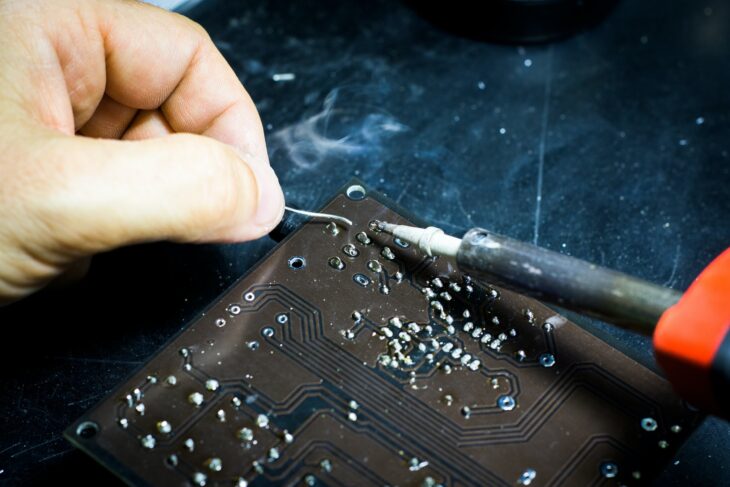The industry development is leading to huge changes every year, and the companies really need to learn about them faster, so they can keep up with it. Also, the trends are different too, and they change every year, depend on what’s new at the moment, or what’s the thing that worked out better previously, that is still adapted to the new conditions on the market. As you can see on this site, these trends lead to advanced solutions in electronics development and let the designers find the most optimal design, that will surely work out nicely, after all those new technologies are applied over it.
When it comes to the electronic manufacturing industry, it should follow the current trends, but at the same time, still keep to proven ways that work all the time, with a little improvement on the way they are accomplishing the process. That means, the manufacturer should embrace the new ideas, especially those that can easily be applied to the current way of working. Technology development is making a huge change in the industry, no matter the field. Basically, that means they can produce more devices in a shorter amount of time, optimize the process, speed it up, and be smarter when planning the shipping.
We should never forget that as the industry develops and becomes more advanced, the world is changing and evolving too, making significant changes in the way the things around us work. On the other hand, these trends and tech developments are following people’s demands and preferences, so we can say that using the newest trends in the electronic industry works in at least two ways. But, how it’s done in 2024? We will see in this article:
Contents
1. Internet of things (or IoT)

img source: unsplash.com
This is one of the trends that is and always be emerging when it comes to industrial development. It makes a connection between plenty of machines and appliances that make the production process nice and smooth. It brings all the useful features together, including the wireless connection between the devices, implementing computers, sensors, using cloud storage, and implementing different technologies.
2. Making things work smart
We all want smart devices. We love our smartphones more than ever, and tablets and laptops too. This technology is a huge trend in the electronic industry too, because it lowers the chances for human error, improves production, maintains the whole system properly, and alerts the line engineers if something is wrong, and also giving them a unique insight into the data, through the whole process. This information helps the engineers who run the manufacturing to optimize the whole production process and make it more efficient.
3. Remote controlling

img source: unsplash.com
Due to the COVID-19 pandemic, most of the companies weren’t able to work regularly as before, including the industries too. They were changing the shifts, optimizing the number of people present at the moment. That means someone still needed to stay at home, even though they have some crucial role in the production process. But, using the newest trends and developments, and of course the cloud-based software, it’s all pretty simple to monitor the manufacturing process no matter where you are.
4. Greener production
The problem with global pollution is bigger than ever. In the past, there were separate parts of the world that were most polluted, but now it seems like the whole world is in some gray or even black phase, which is very sad since we only have this one planet to live on. But, the good news is that a lot of companies and industries are trying to make their manufacturing process as greener as it can be. Sometimes that means they will need to buy new machines, or change the whole approach in the work, or even replace the staff, but it’s all about nature and the environment. In the beginning, this way of working can be even more costly than the regular one, but as soon as you all adapt to it, it will be much better in the future.
5. Easy maintenance

img source: unsplash.com
Smart systems can lead to easy and predictive maintenance, which can result in prevention before some things happen. Depending on the equipment and other supplies, the engineers can easily maintain the whole process, preventing mistakes, and predicting what’s the next step, without improvisations and chances for mistakes. If it’s done properly, it will all work out nicely.
6. Focusing on the consumers
The products are made for the consumers to buy and use, as they think they have to do that. In the past, the relation went business-to-business (or what we know as B2B), but now they are more focused on the consumers (B2B2C), since the industry can directly sell the product to the customer, without shipping it to some store. This is a nice approach for the small businesses and startups, who can’t really make a deal with stores or open theirs, so they set an eCommerce website and work directly with the consumers. It’s also time-saving, and solves a lot of logistic questions, because the industry doesn’t depend on someone else, and it’s all on them.
7. Optimizing the number of employees

img source: unsplash.com
If some process is automated, you only need one or two engineers every shift. The maintenance can be done with an outsource company in many cases. The tech development and emerging trends in the industry may shorten some of the work positions and decrease the number of people who need to be hired. And that’s good for the company owner who can save money on staff. On the other hand, that means fewer open job positions for the people to apply. But, with the right approach, everything can be done properly and work smoothly all the time.
These are the most emerging trends for 2024. As you can see, most of them are already known and expected, since they improve the functionality of the production line, resulting in great outcomes every year. It’s important to know how to do the things, so they can result in an exceptional manufacturing process all the time.
